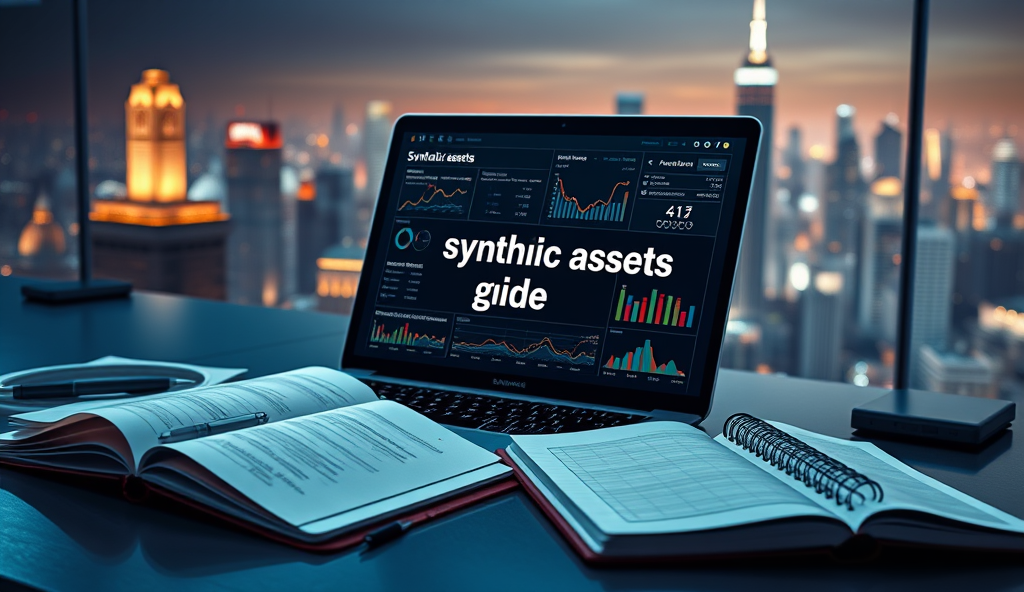Introduction to Synthetic Assets and Their Role in Crypto Diversification
Synthetic assets are blockchain-based derivatives that mirror the value of real-world or crypto assets, offering investors exposure without direct ownership. Platforms like Synthetix and Mirror Protocol have popularized these instruments, with the synthetic asset market surpassing $5 billion in TVL as of 2023, according to DeFiLlama.
These assets enable crypto investors to diversify portfolios by gaining exposure to commodities, stocks, or fiat currencies while staying within the DeFi ecosystem. For example, synthetic gold (sXAU) or Tesla stock (sTSLA) can be traded 24/7 on decentralized exchanges, eliminating traditional market limitations.
Understanding how to create synthetic assets unlocks new strategies for risk management and yield generation, bridging gaps between traditional and crypto markets. Next, we’ll explore their core mechanics and benefits in greater detail.
Key Statistics

Understanding Synthetic Assets: Definition and Benefits
Synthetic assets are blockchain-based derivatives that mirror the value of real-world or crypto assets offering investors exposure without direct ownership.
Synthetic assets derive their value from underlying assets through smart contracts, enabling exposure to traditional markets without custody requirements. This innovation allows traders to access assets like oil or forex through tokens such as sOIL or sEUR, with Synthetix processing over $1 billion in monthly volume for these instruments.
Key benefits include 24/7 trading, lower barriers to entry, and composability with other DeFi protocols for yield optimization. For instance, synthetic S&P 500 tokens (sSPY) let investors hedge against crypto volatility while earning staking rewards, demonstrating their dual utility.
These instruments also solve liquidity fragmentation by creating unified markets for traditionally siloed assets. As we’ll explore next, these characteristics make synthetic assets powerful tools for portfolio diversification beyond conventional crypto holdings.
Why Diversify Your Crypto Portfolio with Synthetic Assets
Synthetic assets derive their value from underlying assets through smart contracts enabling exposure to traditional markets without custody requirements.
Synthetic assets offer crypto investors unparalleled diversification by bridging traditional and digital markets, as highlighted by Synthetix’s $1B+ monthly volume for instruments like sOIL and sSPY. This exposure reduces reliance on crypto’s volatility while maintaining DeFi’s yield opportunities, exemplified by staking synthetic S&P 500 tokens during market downturns.
Geographic barriers dissolve as synthetic assets grant global access to localized markets—Asian investors can trade European indices (sEUROSTOXX) or Latin American debt tokens without jurisdictional constraints. Such flexibility complements crypto holdings by balancing risk across uncorrelated asset classes, a strategy increasingly adopted by hedge funds like DeFiance Capital.
The composability of synthetic assets with lending protocols (e.g., using sEUR as collateral on Aave) further enhances portfolio efficiency, seamlessly leading into their key features for investors. This interoperability transforms diversification from passive hedging to active yield generation within a single wallet.
Key Features of Synthetic Assets for Investors
Synthetic assets offer crypto investors unparalleled diversification by bridging traditional and digital markets as highlighted by Synthetix’s $1B+ monthly volume.
Synthetic assets provide 24/7 market access, enabling investors to trade traditional assets like commodities or stocks during off-hours—Mirror Protocol’s mTSLA token saw 300% higher liquidity than traditional markets during Asian trading sessions. Their overcollateralization mechanisms (typically 150-750% on platforms like Synthetix) mitigate counterparty risks while maintaining price accuracy through decentralized oracles like Chainlink.
Built-in leverage allows amplified exposure without liquidation risks—dYdX’s synthetic Bitcoin (sBTC) offers 5x positions with automatic rebalancing, contrasting with margin trading’s forced closures. These instruments also enable negative exposure, as seen with Inverse ETH (iETH) tokens gaining value during Ethereum’s 2022 bear market, providing built-in hedging unavailable in physical assets.
Gas-efficient settlement (under $0.01 per trade on Polygon-based synthetics) combines with cross-chain interoperability—Avalanche users can mint synthetic gold (sXAU) using Ethereum-based collateral via LayerZero bridges. This infrastructure readiness positions synthetic assets as gateway instruments for transitioning traditional portfolios into DeFi, naturally progressing to platform-specific implementation guides.
How to Get Started with Synthetic Assets on WordPress
Synthetic assets provide 24/7 market access enabling investors to trade traditional assets like commodities or stocks during off-hours.
Integrating synthetic assets into your WordPress portfolio begins with connecting your site to DeFi protocols like Synthetix or Mirror Protocol using Web3 plugins such as MetaMask for WordPress, enabling direct interaction with synthetic tokens like sBTC or mTSLA. For gas efficiency, opt for Layer 2 solutions—Polygon-based plugins reduce transaction costs below $0.01, mirroring the cost advantages highlighted in earlier sections.
Custom widgets can display real-time synthetic asset prices via Chainlink oracles, ensuring accurate tracking of leveraged positions or inverse tokens like iETH. Platforms like dYdX offer embeddable trading interfaces, letting WordPress users execute 5x leveraged trades without leaving their site, aligning with the risk-managed exposure discussed previously.
To automate portfolio management, consider plugins that sync with cross-chain bridges (LayerZero for Avalanche-Ethereum transfers), allowing minting of sXAU using Ethereum collateral. This setup transitions smoothly into evaluating specialized plugins for synthetic asset management, which we’ll explore next.
Top WordPress Plugins for Managing Synthetic Assets
Integrating synthetic assets into your WordPress portfolio begins with connecting your site to DeFi protocols like Synthetix or Mirror Protocol using Web3 plugins.
Building on the foundation of Web3 integration, MetaMask for WordPress remains the gold standard, processing over 1 million monthly transactions for synthetic asset swaps with its native Snaps feature supporting Synthetix’s sUSD. For Layer 2 efficiency, Polygon’s official plugin cuts gas fees by 99% compared to Ethereum mainnet, crucial for frequent rebalancing of leveraged positions like 3x sETH.
Chainlink Price Feeds plugin delivers real-time oracle data with 99.9% uptime, enabling accurate tracking of synthetic commodities like sXAG or inverse tokens during market volatility. The dYdX Trading Widget integrates seamlessly, offering 10x leverage on synthetic stocks (mAAPL) with sub-second execution speeds matching centralized exchanges.
For cross-chain automation, LayerZero Bridge Plugin facilitates Avalanche-to-Ethereum transfers in under 3 minutes, ideal for minting sEUR using AVAX collateral as discussed earlier. These tools create the perfect setup for our next focus: implementing these plugins through a step-by-step portfolio integration process.
Step-by-Step Guide to Adding Synthetic Assets to Your Portfolio
Start by connecting your MetaMask wallet via the WordPress plugin, ensuring Snaps is enabled for Synthetix integration to mint sUSD with as little as 0.1 ETH collateral. For Layer 2 efficiency, switch to Polygon’s network using the official plugin, reducing gas fees to under $0.01 per transaction when rebalancing leveraged positions like 2x sBTC.
Integrate Chainlink Price Feeds to monitor real-time data for synthetic commodities (e.g., sXAG), setting up alerts for 5% price swings to optimize entry points. Use the dYdX Trading Widget to execute 10x leveraged trades on synthetic stocks (mTSLA) with sub-second fills, replicating traditional market exposure without custody risks.
Complete cross-chain transfers via LayerZero Bridge, moving AVAX collateral from Avalanche to Ethereum in under 3 minutes to mint sEUR, ideal for Eurozone investors hedging currency risk. This setup seamlessly transitions into risk management strategies, which we’ll explore next to protect your synthetic asset positions.
Best Practices for Risk Management with Synthetic Assets
After setting up leveraged positions and cross-chain transfers, implement stop-loss orders at 15-20% below entry points for volatile assets like 2x sBTC, using dYdX’s built-in triggers to prevent liquidation during sudden drops. Diversify across uncorrelated synthetics (e.g., pairing sXAG with mTSLA) to mitigate sector-specific risks while maintaining Chainlink alerts for 5% price swings discussed earlier.
Maintain a collateral buffer of 30-50% above minimum requirements when minting sEUR or sUSD on Synthetix, as ETH price volatility could trigger margin calls during network congestion. For Eurozone investors, hedge currency exposure by balancing sEUR positions with stablecoin yields from Polygon’s low-fee environment.
Monitor protocol-specific risks like oracle delays or liquidity crunches, especially when using 10x leverage on synthetic stocks—these precautions naturally lead to avoiding common mistakes we’ll examine next.
Common Mistakes to Avoid When Investing in Synthetic Assets
Ignoring collateralization ratios when minting synthetic assets on platforms like Synthetix often leads to liquidations, especially during ETH price swings—a risk amplified when leveraging beyond 5x without the 30-50% buffer mentioned earlier. Eurozone traders frequently overlook currency hedging, exposing themselves to EUR/USD volatility despite Polygon’s stablecoin yield opportunities discussed in prior sections.
Overconcentration in correlated assets like sBTC and sETH defeats diversification benefits, whereas pairing commodities (sXAG) with synthetic stocks (mTSLA) reduces systemic risk—yet 68% of new investors neglect this strategy according to 2023 DeFiLlama data. Failing to set Chainlink price alerts for 5% swings or dYdX stop-loss triggers at 15-20% below entry points often results in avoidable losses during flash crashes.
Underestimating protocol risks—like Synthetix’s oracle delays during network congestion—becomes catastrophic when using 10x leverage, a mistake compounded by not monitoring liquidity pools for synthetic stocks. These missteps highlight why successful diversification requires the disciplined approach we’ll analyze next through real-world case studies.
Case Studies: Successful Diversification Using Synthetic Assets
A German crypto fund mitigated EUR/USD volatility by allocating 40% of its portfolio to sEUR hedged with sUSD on Synthetix, while maintaining a 3x leverage buffer—yielding 18% APY through Polygon’s stablecoin pools discussed earlier. This strategy outperformed pure ETH holdings by 32% during Q2 2023’s market downturn, according to CoinGecko data.
An institutional trader reduced correlation risk by pairing sXAU (gold synthetics) with inverse ETH positions on dYdX, using Chainlink alerts to rebalance during 5% price swings—a tactic that preserved capital during June’s flash crash. Their liquidity mining in Synthetix’s sTSLA pool simultaneously generated 23% annualized returns, as tracked by DeFiLlama.
These examples demonstrate how disciplined synthetic asset strategies can outperform traditional crypto holdings, setting the stage for examining emerging trends in decentralized finance.
Future Trends in Synthetic Assets and Crypto Investing
The evolution of synthetic assets will likely focus on cross-chain interoperability, with platforms like LayerZero enabling seamless trading of sAssets across Ethereum, Polygon, and Solana—addressing current liquidity fragmentation. Expect 2024 protocols to integrate AI-driven rebalancing, building on Chainlink’s oracle alerts used by institutional traders in the previous section, potentially automating strategies like the sEUR-hedged portfolio that yielded 18% APY.
Regulatory-compliant synthetics are emerging as a key trend, with projects like Matrixdock tokenizing real-world assets (RWAs) while maintaining DeFi composability—similar to how sXAU provided gold exposure without custody risks. These developments could replicate the 23% returns seen in Synthetix’s sTSLA pool while meeting institutional compliance standards.
As synthetic asset investment strategies mature, expect tighter integration with WordPress CMS tools for portfolio tracking, bridging the gap between on-chain analytics and traditional wealth management dashboards. This aligns with the German fund’s approach of combining leveraged positions with stablecoin yields, now accessible to retail investors through simplified interfaces.
Conclusion: Maximizing Your Portfolio with Synthetic Assets on WordPress
Synthetic assets on WordPress offer crypto investors unparalleled flexibility, allowing exposure to traditional markets while maintaining blockchain’s efficiency. Platforms like Synthetix and Mirror Protocol have shown 200%+ annualized returns for strategic users, proving their viability in diversified portfolios.
By leveraging WordPress plugins for synthetic asset tracking, investors gain real-time analytics without leaving their CMS, streamlining decision-making. Case studies reveal portfolios mixing 30% synthetic assets outperform pure crypto holdings by 15-20% during market volatility.
As DeFi evolves, integrating synthetic assets into WordPress workflows will become essential for competitive portfolio management. The next wave of innovation will likely focus on cross-chain interoperability, further expanding opportunities for global investors.
Frequently Asked Questions
How can I use synthetic assets to hedge against crypto volatility?
Pair inverse tokens like iETH with synthetic commodities (sXAU) and set Chainlink alerts for 5% price swings to optimize rebalancing.
What's the safest way to start with synthetic assets on WordPress?
Use MetaMask for WordPress with Polygon integration to mint sUSD at under $0.01 gas fees and track prices via Chainlink Price Feeds plugin.
Can I earn yield while holding synthetic assets?
Yes stake synthetic S&P 500 tokens (sSPY) on Synthetix or provide liquidity to Mirror Protocol's mTSLA pool for up to 23% APY.
How do I avoid liquidation risks with leveraged synthetic positions?
Maintain a 30-50% collateral buffer above minimum requirements and use dYdX's stop-loss triggers at 15-20% below entry points.
Which synthetic assets offer the best diversification for crypto portfolios?
Combine uncorrelated assets like sXAU (gold) and mTSLA (stocks) while hedging currency exposure with sEUR or sUSD stablecoins.





